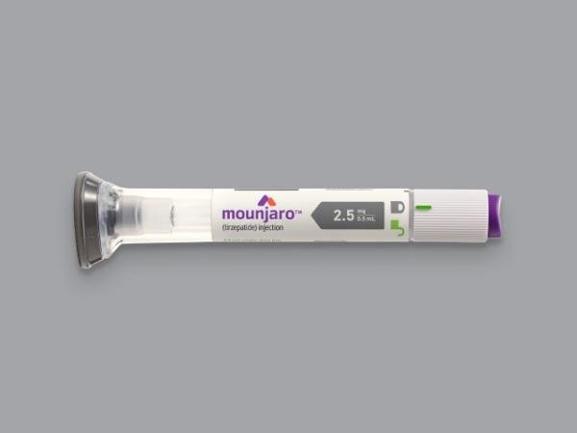Tirzepatide Disease Interactions
There are 5 disease interactions with tirzepatide.
Tirzepatide (applies to tirzepatide) thyroid cancer
Major Potential Hazard, Moderate plausibility. Applicable conditions: Multiple Endocrine Neoplasia Type II, Thyroid Tumor
Tirzepatide is contraindicated in patients with a personal or family history of medullary thyroid carcinoma (MTC) and in patients with multiple endocrine neoplasia syndrome type 2. Patients with elevated serum calcitonin or thyroid nodules noted on physical examination or neck imaging should be further evaluated. Patients should be counseled regarding the potential risk for MTC with the use of tirzepatide and should be informed of symptoms of thyroid tumors.
Tirzepatide (applies to tirzepatide) acute kidney injury
Moderate Potential Hazard, Moderate plausibility. Applicable conditions: Dehydration, Diarrhea, Renal Dysfunction, Vomiting
Tirzepatide has been associated with gastrointestinal adverse reactions (including nausea, vomiting, diarrhea); such events may lead to dehydration, which could cause acute kidney injury if severe. There have been postmarketing reports of acute kidney injury and worsening of chronic renal failure (which may sometimes require hemodialysis) in patients treated with glucagon-like peptide-1 (GLP-1) receptor agonists; some of these events were reported in patients without known underlying renal disease, and most of the reported cases occurred in patients who experienced nausea, vomiting, diarrhea, or dehydration. Renal function should be monitored when starting or escalating doses of tirzepatide in patients with renal dysfunction reporting severe gastrointestinal adverse reactions. No dose adjustment is recommended for patients with renal dysfunction.
Tirzepatide (applies to tirzepatide) pancreatitis
Moderate Potential Hazard, Moderate plausibility.
Acute pancreatitis (including fatal and nonfatal hemorrhagic or necrotizing pancreatitis) has been observed in patients treated with glucagon-like peptide-1 (GLP-1) receptor agonists; acute pancreatitis has been reported in patients treated with tirzepatide in clinical trials. Tirzepatide has not been studied in patients with history of pancreatitis; it is unknown if such patients are at higher risk of developing pancreatitis on tirzepatide. After initiation of tirzepatide, patients should be observed carefully for signs/symptoms of pancreatitis (including persistent severe abdominal pain [sometimes radiating to the back], with or without vomiting); if pancreatitis is suspected, tirzepatide should be discontinued and appropriate management should be started.
Tirzepatide (applies to tirzepatide) retinopathy
Moderate Potential Hazard, Moderate plausibility. Applicable conditions: Diabetic Retinopathy
Tirzepatide has not been studied in patients with nonproliferative diabetic retinopathy requiring acute therapy, proliferative diabetic retinopathy, or diabetic macular edema; caution is recommended in these patients. Rapid improvement in glucose control has been associated with a temporary worsening of diabetic retinopathy. Patients with history of diabetic retinopathy should be monitored for progression of diabetic retinopathy.
Tirzepatide (applies to tirzepatide) severe GI disease
Moderate Potential Hazard, Moderate plausibility. Applicable conditions: Gastroparesis
Use of tirzepatide has been associated with gastrointestinal adverse reactions (sometimes severe). Because tirzepatide has not been studied in patients with severe gastrointestinal disease (including severe gastroparesis), it is not recommended in these patients.
Switch to professional interaction data
Tirzepatide drug interactions
There are 414 drug interactions with tirzepatide.
Tirzepatide alcohol/food interactions
There are 3 alcohol/food interactions with tirzepatide.
More about tirzepatide
- tirzepatide consumer information
- Check interactions
- Compare alternatives
- Reviews (1,842)
- Latest FDA alerts (3)
- Side effects
- Dosage information
- During pregnancy
- Support group
- Drug class: GLP-1 Agonists (Incretin Mimetics)
- Breastfeeding
- En español
Related treatment guides
Drug Interaction Classification
| Highly clinically significant. Avoid combinations; the risk of the interaction outweighs the benefit. | |
| Moderately clinically significant. Usually avoid combinations; use it only under special circumstances. | |
| Minimally clinically significant. Minimize risk; assess risk and consider an alternative drug, take steps to circumvent the interaction risk and/or institute a monitoring plan. | |
| No interaction information available. |
Further information
Always consult your healthcare provider to ensure the information displayed on this page applies to your personal circumstances.


